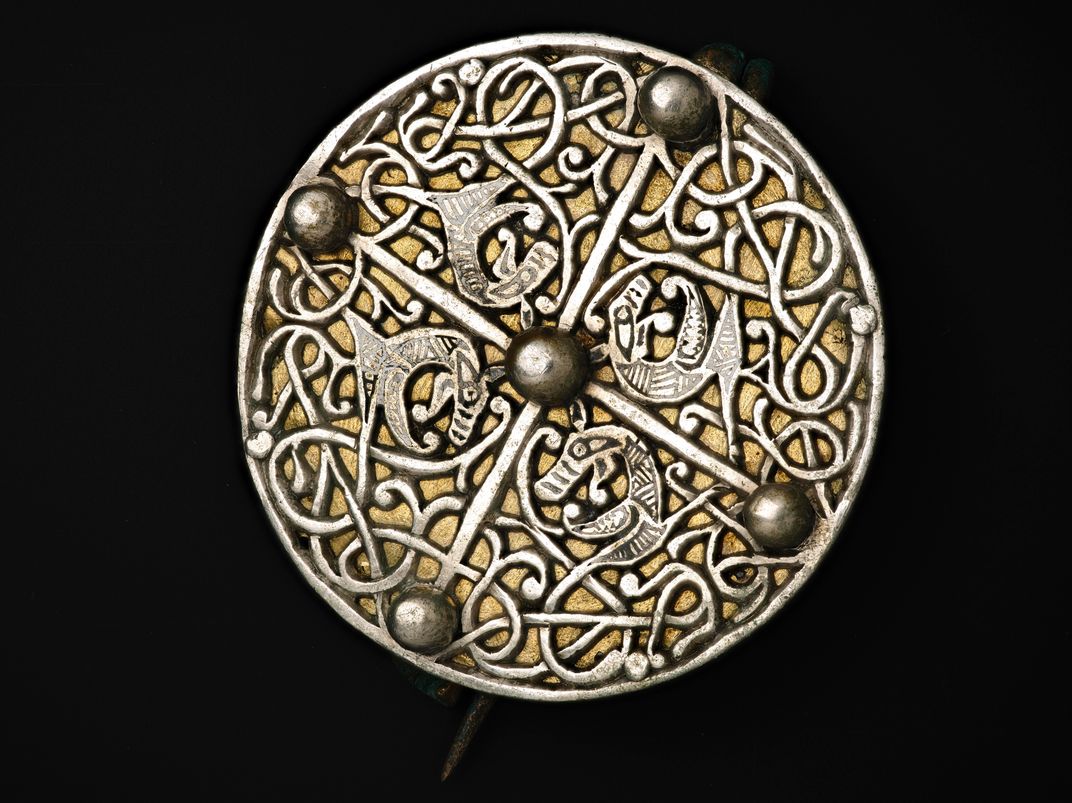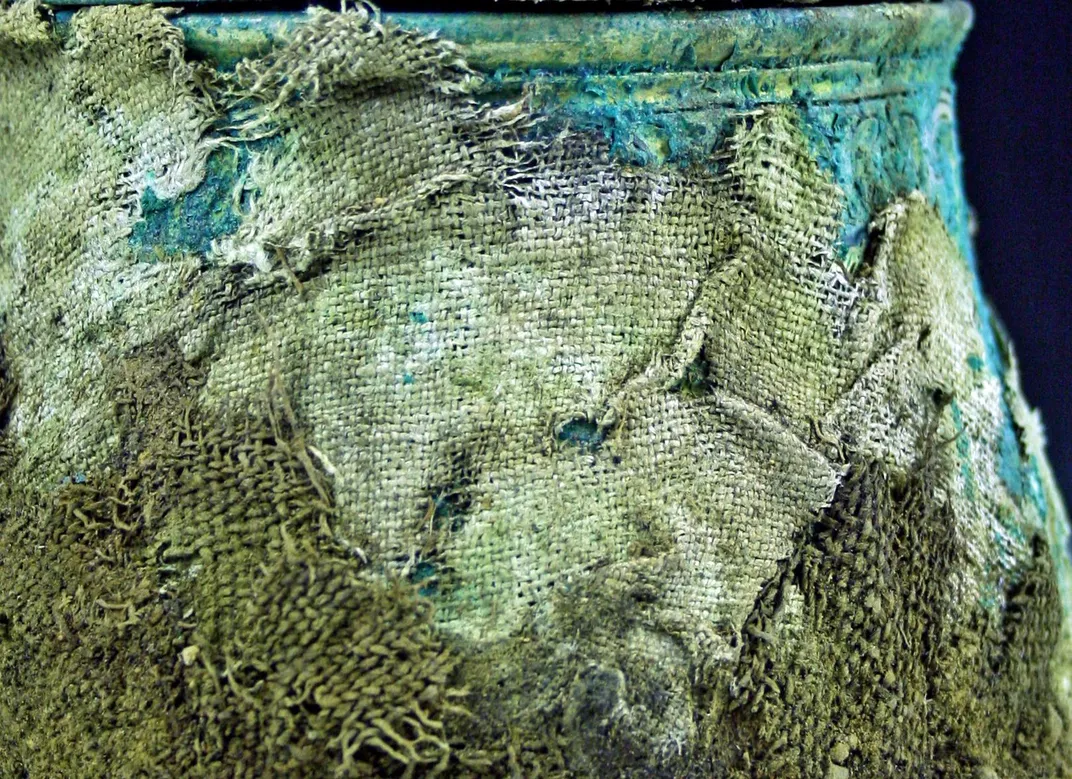Trove of Viking-Age Treasures Makes Its Long-Awaited Public Debut
The Galloway Hoard, a collection of 100 rare artifacts buried in Scotland around 900 A.D., is finally on view
/https://tf-cmsv2-smithsonianmag-media.s3.amazonaws.com/filer/97/fa/97fad1e3-93b0-4104-a52c-dc6ad225b795/teasting.png)
In 2014, an amateur treasure hunter in Balmaghie, Scotland, unearthed the Galloway Hoard, a stunning collection of more than 100 artifacts, including medieval coins, an ornate silver cross and one of the largest silver Carolingian pots ever found. Described by National Museums Scotland as the “richest collection of rare and unique Viking-age objects ever found in Britain or Ireland,” the trove of treasures is finally making its public debut in a much-anticipated national tour.
As Alison Campsie reports for the Scotsman, experts have spent the past several years painstakingly removing mud and debris from the priceless objects, which went on view at the National Museum of Scotland (NMS) in Edinburgh last week. Items too fragile to be displayed are presented in 3-D.
“A unique combination of familiar objects, exotic materials and exceptional preservation makes the Galloway Hoard a fascinating find,” says Martin Goldberg, principal curator of medieval archaeology and history at NMS, in a statement. “Conservation work is allowing us to see these objects clearly for the first time, and our research so far is pointing to a new understanding of Scotland in the international context of the earliest Viking Age.”
According to a second Scotsman article by Campsie, recent research suggests that four different people—or groups—buried the hoard around 900 A.D. Separated into two layers (a top one and a three-part lower level), the trove includes silver arm rings bearing Anglo-Saxon abbreviations. Because the arm rings are of varying quality, the team suspects that their owners may not have been equal in status.
“There is something unexpected about the Galloway Hoard at every turn,” Goldberg tells BBC News’ Giancarlo Rinaldi. “It just keeps telling more and more stories.”
Per the statement, the top layer of the trove contained a package of silver bullion and a rare, intricately decorated cross. (Last year, NMS released stunning images of the newly restored artifact, which likely belonged to a high-ranking cleric or king, as Goldberg told the Observer’s Dalya Alberge at the time.)
Below these objects rested a layer divided into three distinct sections: first, a leather-wrapped parcel of silver bullion that was double the size of the first one; second, the four arm rings and a small wooden box housing three gold items; and, finally, an ornately carved silver jar filled with beads, brooches, bracelets and other curios.
Researchers used X- ray imaging to create 3-D models of the jar without removing its cloth covering. Based on radiocarbon dating of wool wrapped around the vessel, it dates to between 680 and 780 A.D., writes Laura Geggel for Live Science. Interestingly, the analysis revealed that the container wasn’t crafted in continental Europe, as the team had previously theorized.
“[T]he decoration and design show leopards, tigers and Zoroastrian religious symbols, all of which suggest that it is a piece of Central Asian metalwork from halfway round the known world,” says Goldberg in the statement.
David Keys of the Independent posits that medieval Scots divided the trove into two layers to trick anyone who stumbled onto it. Hidden some three inches beneath the first level—a possible “‘sacrificial’ decoy”—the second held a richer, and far more valuable, trove of treasures. This layer boasted a rock crystal flask with a gold spout, a bird-shaped gold pin and quatrefoil brooches, among other artifacts.
Experts will continue to analyze the finds to learn more about the trove’s owners and life in medieval Scotland. According to a statement, the Arts and Humanities Research Council recently awarded $1.4 million (£1 million) to a joint, three-year research project spearheaded by NMS and the University of Glasgow.
“The conservation and the research work so far have really gone hand in hand, revealing fantastic details on individual objects which have enabled us to start piecing together the story of the hoard,” conservator Mary Davis tells BBC News. “I'm pleased that the exhibition conveys a real sense of that process of discovery.”
“The Galloway Hoard: Viking-Age Treasure” is on view at the National Museum of Scotland in Edinburgh through September 12. Afterward, the exhibition will travel to the Kirkcudbright Galleries (October 9–July 10, 2022) and the Aberdeen Art Gallery (July 30–October 23, 2022).
/https://tf-cmsv2-smithsonianmag-media.s3.amazonaws.com/accounts/headshot/Isis_Davis-Marks_thumbnail.png)

/https://tf-cmsv2-smithsonianmag-media.s3.amazonaws.com/filer/99/d5/99d54724-68e2-427e-8afc-e6bb61275827/beads_curios_and_heirloom_objects_were_bundled_and_strung_together_resting_as_a_group_on_a_silver_brooch-hoop_at_the_top_of_the_lidded_vessel_in_the_galloway_hoard.jpg)


/https://tf-cmsv2-smithsonianmag-media.s3.amazonaws.com/filer/41/29/41293d73-b04f-43c1-9860-4e037a889eb0/conserved_bird_pin_from_the_galloway_hoard.jpg)

/https://tf-cmsv2-smithsonianmag-media.s3.amazonaws.com/accounts/headshot/Isis_Davis-Marks_thumbnail.png)